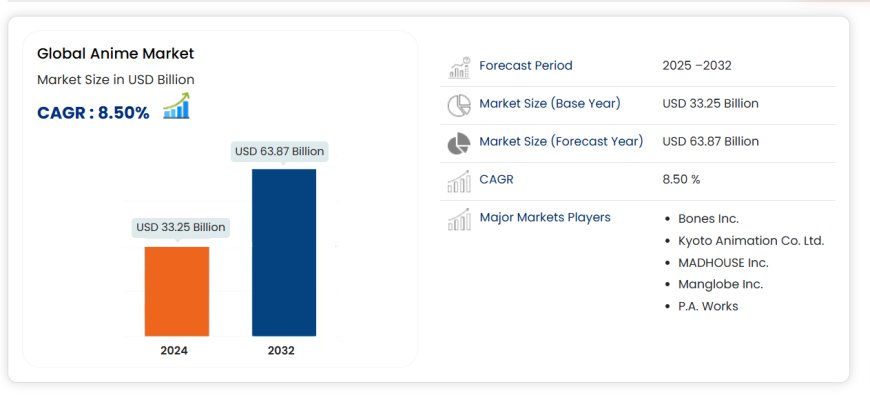The Global Anime Market: Evolution, Trends, Challenges, and Growth Drivers
During the forecast period of 2025 to 2032 the market is likely to grow at a CAGR of 8.50%, primarily driven by the widespread accessibility of diverse anime content through global streaming platforms

Introduction
Anime, a distinctive form of animation originating from Japan, has transformed from a niche cultural export into a global entertainment powerhouse. With its unique storytelling, diverse genres, and artistic styles, anime has captivated audiences worldwide. This comprehensive analysis delves into the evolution of the anime industry, current market trends, challenges faced, market scope, size, and the key factors propelling its growth.
The Evolution of Anime
The roots of anime trace back to the early 20th century, but it was in the 1960s that it began to take shape as a distinct medium, notably with Osamu Tezuka's works like "Astro Boy." The subsequent decades saw the rise of iconic series such as "Sailor Moon," "Dragon Ball Z," "Pokémon," and "Yu-Gi-Oh!," which played pivotal roles in introducing anime to international audiences. The advent of the internet and streaming platforms in the 21st century further accelerated anime's global reach, making it more accessible than ever before.Teen Vogue
Market Trends
-
Streaming Platforms and Global Accessibility: The proliferation of streaming services like Crunchyroll, Netflix, and Amazon Prime has made anime readily available to a global audience. These platforms have not only licensed existing content but have also invested in producing original anime series, catering to diverse viewer preferences.
-
Diverse Storytelling and Representation: Modern anime increasingly explores a wide array of themes, including multicultural narratives, LGBTQ+ representation, and stories highlighting underrepresented communities. This inclusivity resonates with a broader audience, especially among younger viewers seeking diverse content.The Times of India
-
Merchandising and Cross-Media Integration: Anime's influence extends beyond television and film into merchandise, video games, and live events. Collaborations between anime franchises and fashion brands, gaming companies, and other media have created multifaceted revenue streams and enhanced fan engagement.
-
Celebrity Endorsements and Mainstream Acceptance: Public figures and celebrities openly expressing their appreciation for anime have contributed to its mainstream acceptance. This cultural shift has helped dispel previous stigmas associated with anime, positioning it as a respected art form and entertainment medium.
Challenges
-
Production Constraints: The demand for high-quality anime content has put pressure on studios, leading to concerns about animator workloads, tight schedules, and resource limitations. Ensuring sustainable production practices is essential for the industry's long-term health.
-
Market Saturation and Competition: The surge in anime content has led to a crowded market, making it challenging for new series to stand out. Studios and creators must innovate to capture and retain audience attention amidst fierce competition.
-
Cultural Sensitivity and Localization: As anime reaches diverse global audiences, adapting content to align with different cultural norms and sensitivities without compromising the original narrative poses a significant challenge.The Times of India
-
Piracy and Intellectual Property Issues: Unauthorized distribution of anime content remains a concern, affecting revenue streams and undermining the efforts of creators and distributors. Combating piracy through legal avenues and accessible platforms is crucial.
Market Scope
The anime market encompasses various segments:The Business Research Company+1Research and Markets+1
-
Television and Streaming: Serialized anime series continue to be a staple, with streaming platforms expanding their libraries to include both classic and new titles.
-
Films and Theatrical Releases: Anime movies, both standalone and adaptations of series, have achieved significant box office success globally.
-
Merchandise and Licensing: From action figures to apparel, anime-related merchandise constitutes a substantial portion of the industry's revenue.
-
Gaming and Interactive Media: Anime-inspired video games and collaborations have broadened the medium's interactive appeal.
-
Live Events and Conventions: Events like AnimeJapan and Comiket serve as hubs for fan engagement, industry announcements, and cultural exchange.Wikipedia
Market Size
The global anime market has demonstrated robust growth:
-
In 2024, the market was valued at approximately USD 81.96 billion.Precedence Research
-
By 2025, it is projected to reach USD 89.77 billion.Precedence Research
-
Forecasts indicate the market could surpass USD 203.68 billion by 2034, growing at a compound annual growth rate (CAGR) of 9.53% from 2025 to 2034. Precedence Research
Regionally, the Asia-Pacific area dominates the market, accounting for 42% of the global share in 2024. The Middle East is emerging as a promising market, with significant growth potential during the forecast period. Precedence Research
Factors Driving Growth
-
Global Fanbase Expansion: The increasing number of anime enthusiasts worldwide, particularly among younger demographics, fuels demand for diverse content and related products.
-
Technological Advancements: Improvements in animation technology and digital distribution have streamlined production processes and broadened content accessibility.
-
Strategic Partnerships and Investments: Collaborations between Japanese studios and international companies, such as the joint venture Hayate Inc. by Aniplex and Crunchyroll, aim to produce high-quality anime for global audiences. Wikipedia
-
Cultural Integration and Acceptance: Anime's incorporation into global pop culture, through fashion, music, and celebrity endorsements, has solidified its status as a mainstream entertainment form.
-
Diversification of Content: The exploration of various genres and themes allows anime to cater to a wide range of interests, attracting new viewers and retaining existing fans.
Conclusion
The anime industry stands at a pivotal juncture, characterized by unprecedented global reach and influence. While challenges persist, the sector's adaptability, creative innovation, and dedicated fanbase position it for sustained growth. As anime continues to evolve, embracing diverse narratives and leveraging technological advancements, it is poised to remain a dynamic and integral component of the global entertainment landscape.
Other Trending Reports
https://www.databridgemarketresearch.com/reports/global-antifreeze-proteins-market
https://www.databridgemarketresearch.com/reports/global-consumer-electronics-packaging-market
https://www.databridgemarketresearch.com/reports/global-dynamically-tuned-gyroscopes-market
https://www.databridgemarketresearch.com/reports/global-andalusite-market
https://www.databridgemarketresearch.com/reports/global-fiber-web-hosting-service-market
https://www.databridgemarketresearch.com/reports/global-herpes-zoster-drug-market
https://www.databridgemarketresearch.com/reports/europe-api-management-market
https://www.databridgemarketresearch.com/reports/middle-east-africa-api-management-market
https://www.databridgemarketresearch.com/reports/north-america-advanced-wound-care-market





























































































































































